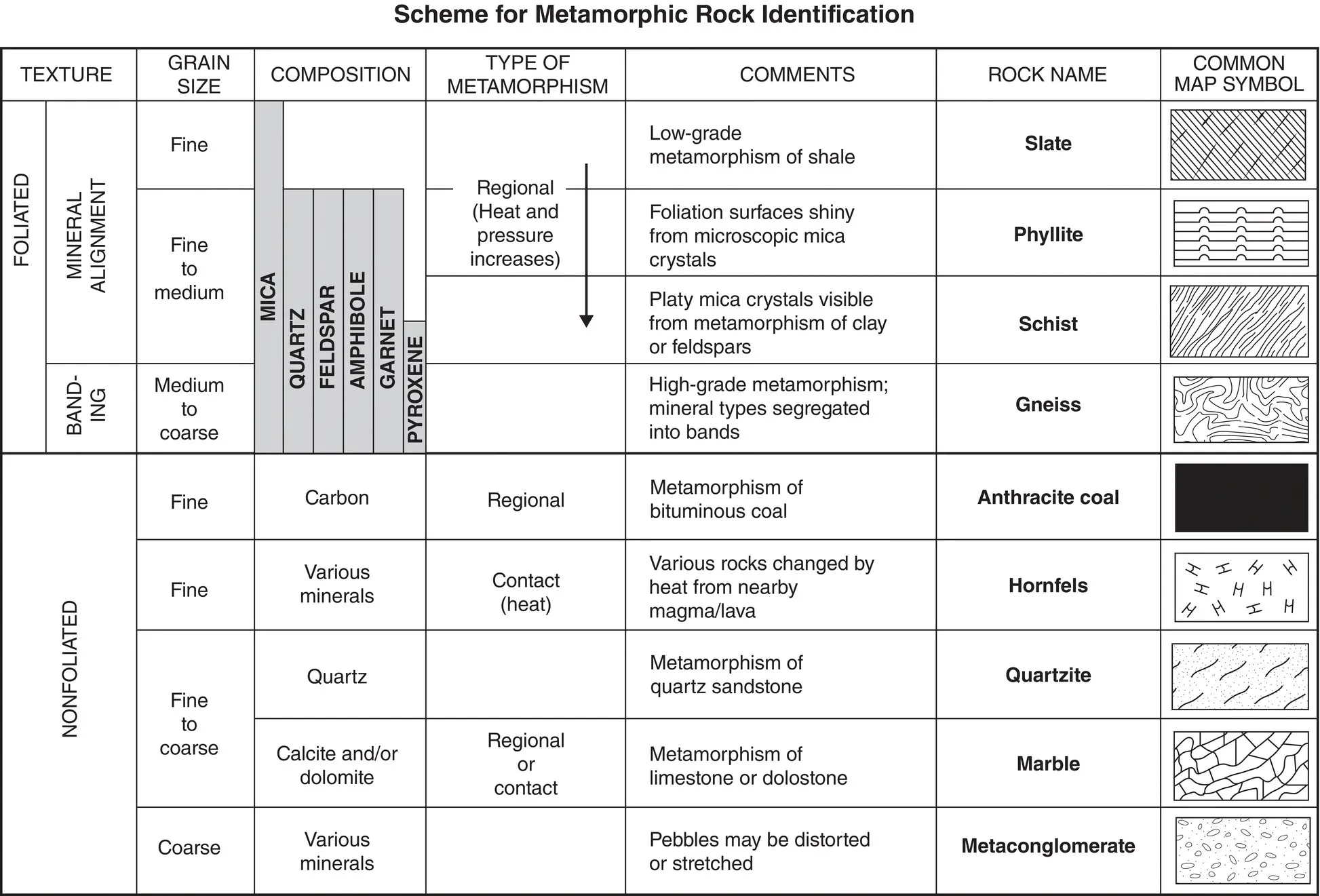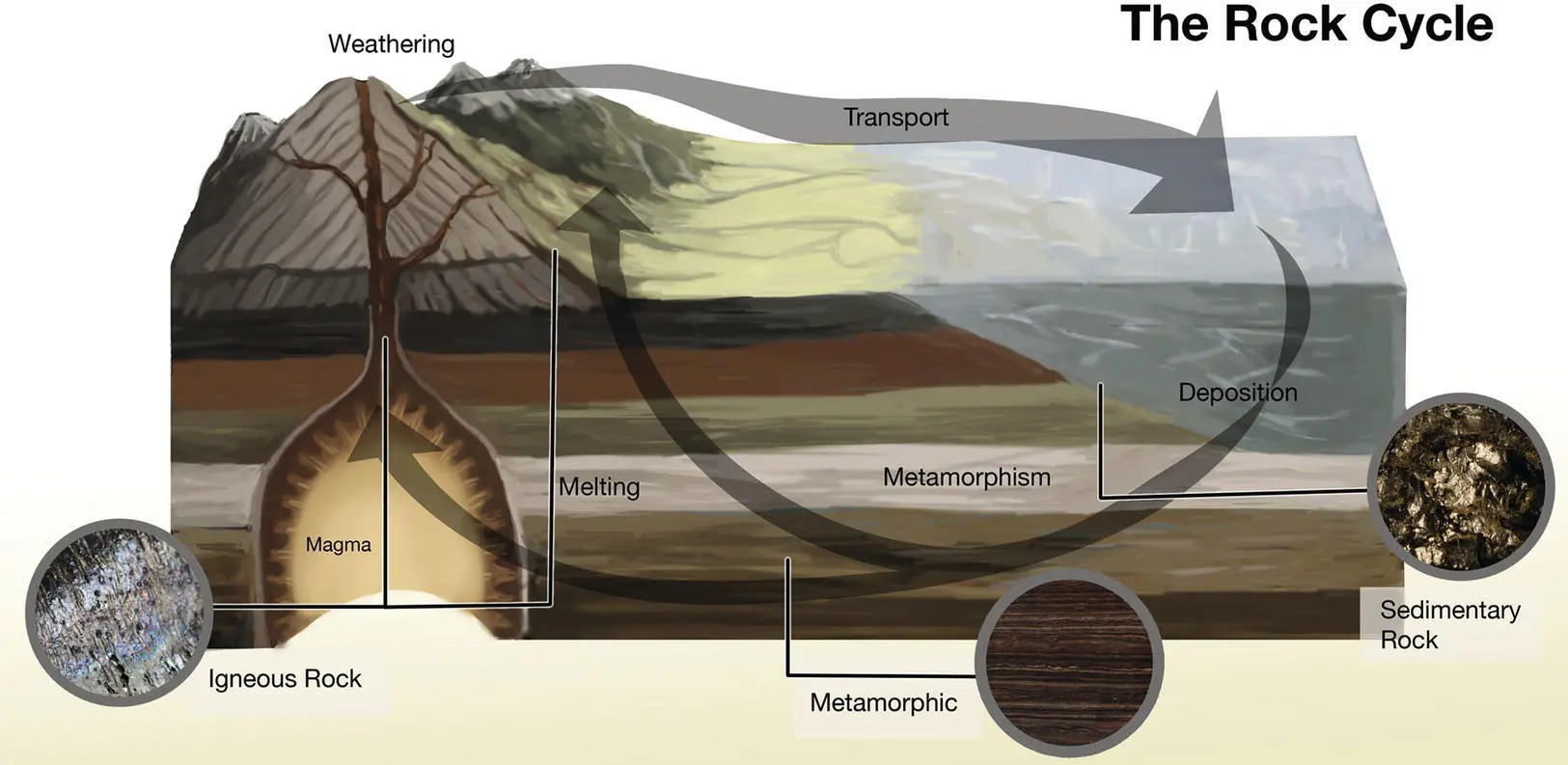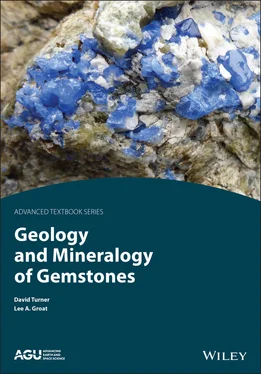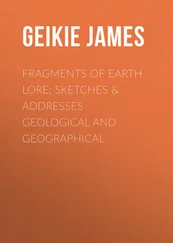Sedimentary rocks form by several processes generally tied to physical erosion, transport and redeposition, chemical precipitation, or biological precipitation. Physical erosion and weathering of an existing rock can form a clastic sedimentary rock, such as a sandstone, siltstone, or mudstone. These rocks are composed of the fragments and grains of the rock(s) that were being eroded to form the sediment. Chemical precipitation at the Earth’s surface can occur when a body of water such as a lake or inland sea undergoes sufficient evaporation to form layers of evaporitic minerals, such as salt. Biological precipitation of minerals includes the production of coral reefs, sediments composed of shells, and deposition of plant material in swamps to form coal.
The unconsolidated sediments themselves are transformed into rocks via a process called diagenesis or lithification, which physically and chemically cements the sedimentary grains together. Like metamorphism, this process involves heat, pressure, and percolating fluids but not to such a degree that the rock’s mineralogy or structure is drastically transformed.
Metamorphic rocks are formed by the modification or alteration of preexisting rocks (igneous, metamorphic, and sedimentary) via a geological process termed metamorphism. The processes that transform or metamorphose rocks involve heat and/or pressure and very often fluids percolating through the subsurface. Rocks can be compressed and new minerals may be generated that are more stable under the new temperature and/or pressure conditions. Pressure is often the result of compressional tectonic forces generated when plates collide; this can also generate heat. In addition, pressure and temperature will increase with depth into the Earth’s crust. Just as increasing pressure and temperature can result in new metamorphic minerals forming, decreasing these pressure and temperature conditions can also lead to mineralogical changes and therefore metamorphism. Generally speaking, when a rock is experiencing increasing temperature and pressure changes it is termed “Prograde metamorphism” and during decreasing conditions it is termed “Retrograde metamorphism”. In the context of gem formation, some gemstones require high temperatures and pressures to become stable and allow growth. For example, marble‐hosted sapphires and rubies generally form at pressures above 5 kilobars (~20 km depth) with temperatures reaching over 600°C, often the result of continent–continent collisional zones.

Figure 2.11 Simple diagram for metamorphic rock descriptions based primarily on texture (foliated vs. nonfoliated). Schematic from ESProjects under Creative Commons.

Figure 2.12 This schematic of the Rock Cycle illustrates some of the most common pathways or process that geological materials are subjected to. Examples include partial melting of mantle material to form magma; magma crystallizing to form igneous rocks; weathering and erosion of igneous and metamorphic rock to produce sediments that lithify to form sedimentary rocks; some igneous and sedimentary rock undergo tectonic burial and metamorphism to form metamorphic rock. Spencer Sutton / Science Source.
The rock cycle ( Figure 2.12) is a concept that describes how rocks can be transformed by various Earth processes into other rock types in the threefold classification. Note that not every rock has to pass through each of the stages in the rock cycle. For example, sedimentary rocks can be weathered into sediments without being subjected to metamorphism or melting, igneous rocks can be metamorphosed, and metamorphic rocks can undergo multiple stages of metamorphism.
2.4 Metasomatism and Hydrothermal Fluids
Gemstones can also be formed through the modification of existing rocks by hot fluids, known as hydrothermal fluids, passing through the Earth’s crust. These hydrothermal fluids contain various dissolved elements and compounds and are often out of chemical equilibrium with the rocks they are passing through. Chemical reactions between the rocks and fluids are common, with the fluids affecting the host rocks and imparting their chemical signatures. When these reactions take place, components from the host rocks can also affect the chemistry of the fluids. These processes are termed metasomatism. Hydrothermal fluids travel from areas of high temperature and/or pressure to areas of low temperature and/or pressure, and so generally move upwards within the crust. They favor geological structures with open or interconnected spaces but can also infiltrate or diffuse through solid rock ( Figure 2.13). Cooling and precipitation of their dissolved components into minerals often take the form of veins.
2.5 Geological Structures
The geological processes that lead to the three main rock types also give rise to a variety of geological structures, such as faults and folds. Faulting and folding can affect any rock type.
Faults are breaks or discontinuities in bedrock where rocks have failed in a brittle fashion. Faults may be small and little offset is seen between the two opposing rocks, or they may be very large features that extend to great depths and lengths. Faults may arise due to compressional, extensional, and transverse forces applied to the Earth’s dynamic crust, as well as combinations of these forces through geological time ( Figure 2.14). Larger fault systems are sometimes referred to as shear zones and can comprise anastomosing networks of faults. Fault systems can provide preferential pathways for magmas and hydrothermal fluids to ascend within the crust, and also result in the juxtaposition of geochemically and geologically contrasting rock types.
Folds also represent past tectonic activity acting upon the Earth’s crust; however, they require plastic deformation as opposed to brittle deformation. Folds and resulting foliation are most strikingly observed in sedimentary rocks that started out as layered or stratified and were subjected to predominantly compressional forces in the Earth’s crust ( Figures 2.15and 2.16). The response of the rocks in a compressional regime is to shorten in the direction of compression and the Earth accommodates those forces through folding, just as a stack of loose papers would develop folds if pushed from the sides. Folds can also develop in extensional or tensional stress regimes, such as thick sedimentary basins with normal faulting and deformation or detachment features in extensional shear zones. Similar to faults, folding patterns may result in juxtaposed rock types and pathways through which magmas and hydrothermal fluids might preferentially travel along or through. These settings are important for laying the specific conditions in which certain gemstones deposits may form. Generally speaking, the most dramatic folding happens on a very large scale during continental building and collisional events, and fold patterns can extend over hundreds of kilometers with complex geometries.
2.6 Important Rock Types for Gemstone Deposits
Gemstones can be found in all three major rock classes but there are a few specific rock types that are most important. Kimberlites are arguably the most important rock type for gemstones, as these rare rocks represent the final stages of magmatism that bring diamonds from deep in the Earth towards the surface. They originate deep in the Earth’s interior and have distinct chemistry. Generally speaking, they are high in carbon dioxide (CO 2), potassium (K) and magnesium (Mg) and low in silicon (Si). Granitic rocks that have undergone considerable chemical fractionation are also important, as they become gradually more enriched in rare elements, such as beryllium (Be) and boron (B), which are essential components for several gemstones, such as aquamarine. Similarly, pegmatites that are enriched in rare elements are also very important for producing many varieties of gemstones, such as tourmaline. Sedimentary rocks of importance include limestones and evaporites. Although gemstones are not generally found in these rocks they are important protoliths for metamorphic gemstone deposits (such as marble‐hosted corundum). These concepts and specific rock types are discussed in greater detail in their relevant chapters.
Читать дальше














